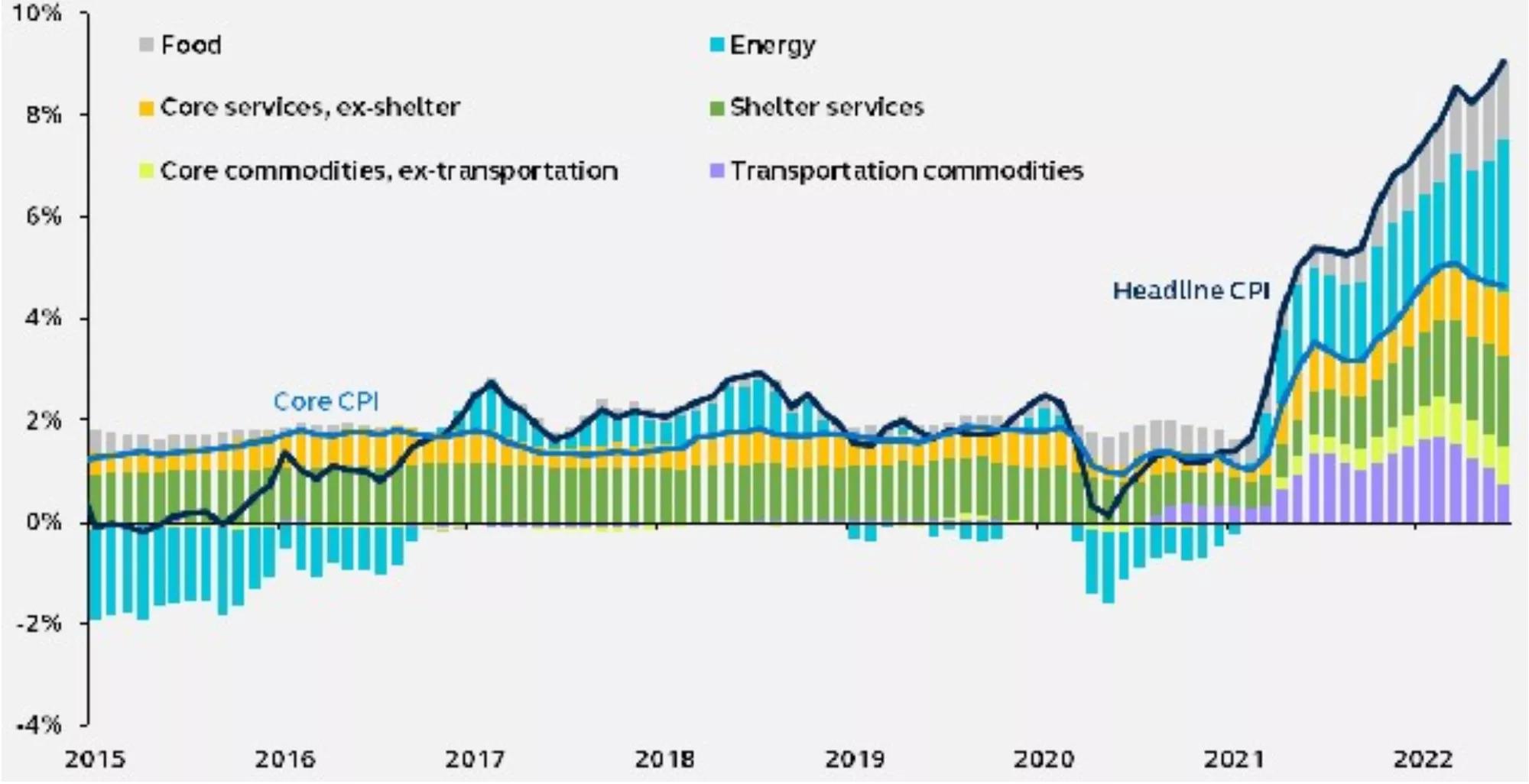U.S. inflation continues to rise at a blistering pace, reaching a fresh four decade high at 9.1% y/y. Stubborn prices means the Federal Reserve (Fed) will need to hike even more aggressively—raising recession risk for early 2023 and exacerbating challenges for risk assets.

Contribution to headline inflation
Year-over-year, 2015-present

Bureau of labor statistics, Principal Global Investors. Data as of July 13, 2022.
Headline U.S. CPI reached a fresh four decade high at 9.1% y/y in June, surpassing even elevated expectations and firmly dispelling any lingering hopes that the Federal Reserve (Fed) could soon end its hiking cycle.
While recent easing in commodity prices should provide some relief for the next few CPI readings, core CPI, which excludes food and energy, will likely remain uncomfortably high.
- Worth around 40% of the core CPI basket, shelter inflation is particularly sticky. Since house price appreciation has yet to peak and typically takes around 18 months to flow into shelter inflation, this important component will likely be elevated for some time.
- Core services (ex-shelter) inflation is currently being bolstered by summer vacation spending. Although pressures may reduce in the autumn, a spending shift from goods to services is also characteristic of the post-COVID lifting of restrictions.
- Durable goods prices have shown surprising resilience to weakening economic growth. However, as households start to cut discretionary spending as recession approaches, the category is vulnerable to deflationary pressures.
Fed policy cannot directly impact food or energy inflation, while rate hikes so far have done little to slow core CPI components which are, traditionally, more responsive to monetary policy. As such, the Fed must continue hiking aggressively if it wants to get a handle on the inflation problem, even if it means speeding up a recession problem.
Wall Street Journal Custom Content is a unit of The Wall Street Journal advertising department. The Wall Street Journal news organization was not involved in the creation of this content.
Investing involves risk, including possible loss of principal. Past performance is no guarantee of future results and should not be relied upon to make an investment decision
The information presented has been derived from sources believed to be accurate; however, we do not independently verify or guarantee its accuracy or validity. Any reference to a specific investment or security does not constitute a recommendation to buy, sell, or hold such investment or security, and does not take account of any investor’s investment objectives or financial situation and should not be construed as specific investment advice, a recommendation, or be relied on in any way as a guarantee, promise, forecast or prediction of future events regarding an investment or the markets in general. The opinions and predictions expressed are subject to change without prior notice.
Principal Funds, Inc. is distributed by Principal Funds Distributor, Inc.
For Public Distribution in the United States. For Institutional, Professional, Qualified and/or Wholesale Investor Use Only in other Permitted Jurisdictions as defined by local laws and regulations.
Principal® , Principal Financial Group® , and Principal and the logomark design are registered trademarks of Principal Financial Services, Inc., a Principal Financial Group company, in the United States and are trademarks and services marks of Principal Financial Services, Inc., in various countries around the world.
Principal Global Investors leads global asset management at Principal.®
2319092


